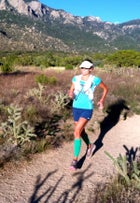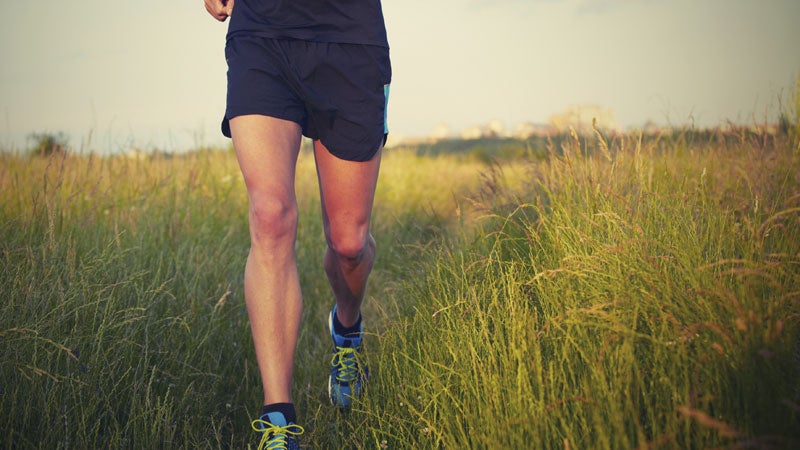I have been pretty quiet on the topic of running lately, but not because I haven’t been running. I’ve been rebuilding.
 Author Katie Arnold training for an ultramarathon
Author Katie Arnold training for an ultramarathonAfter a couple months’ hiatus, I’ve started training and running seriously again, slowly building up my endurance and speed. I’ve set some goals and registered for a few races in the coming months, but I’m purposefully keeping plans a little vague, so I can stay open to how I feel, and let my body and spirit be my guide to what I run, and how far. I’m rebuilding my physical fitness and strength, and also my inner strength.
You could call this mental training, but it’s more than that. What needs shoring up is not how I think about running, but I how I feel about it: the conviction that I’m not running for results or external rewards, but for the joy and freedom of moving simply on my own two feet over long distances through nature. The intuitive realization that how I fare when I race doesn’t matter as much as how I feel when I run.
I spent much of the past two years running this way. I’ve been a runner my whole life, but I only stumbled into competitive ultra racing in 2012. I didn’t know what I was doing, didn’t have a coach or a training plan or even a watch. I ran trails because there was a purity to it and it felt good, and because I had spent a long, dark year mourning my father’s death. I wasn’t consciously trying to out-run my grief as much as break free from it, heal myself by doing what made me feel strong and happy and alive. I posted some modest victories here and there, staved off all but the most minor of injuries, and through it all managed to keep running from my heart, not my head.
This was one more thing I didn’t know: how rare and fleeting this can be.
Last December, something shifted. I got caught up in what other runners were doing. It was hard not to. I’d signed up for the most illustrious 50-mile ultra marathon in the country, stacked with a deep field of professional, elite runners. I’d been goofing around with my running until now, but this would be the real test. Would I measure up? Increasingly, this question seemed to matter to me.
Well, I did and I didn’t. Like everything in life, it depends on how you look at it. Either way, the race left me with a kind of hangover. I’d glutted myself on the image of running, the superficial rewards, and the obscure celebrity of ultra athletes, and lost—or at least misplaced—the feeling of why I run in the first place. In his excellent memoir, , the Japanese novelist and marathon runner Haruki Murakami describes the “runner’s blues fog” that lasted for months after he completed his first 100K race. Like Murakami, I was burned out. It was December, and dark, and it had begun to snow, and all I wanted to do was ski and bob around in a warm, chlorinated pool and sit quietly and let my creaky body rest.
Most runners, whether they’re enthusiastic amateurs or a top-ranked elites, have an off-season. For me, and for many others in cold and mountainous climes, I suspect, it’s winter. This is a healthy time for your body to recover and rest, heal pesky injuries, put in some time cross-training at the gym, and maybe more important, give your brain a break from obsessively thinking about running. There’s a simplicity and order to following the seasons. I vowed to take to take the rest of December and January off from training, to ski when it snowed, and run like a normal person: short, regular jogs, a few miles, an hour here, and hour there.
When February rolled around, I told myself I was ready to start training. Then it snowed for the first time in a month, so I put it off for a week to ski instead. By the middle of the month, my procrastination had reached full boil. I wanted to run, not because I wanted to run as much as I wanted to stop dreading it. As a motivating factor, fear is not nearly as sustainable as joy, but in the beginning at least, it works just the same.
And so I began. That first week, my long run was 12 miles. I picked the flattest trail I knew, along the railroad tracks through blustery high desert, skirting lonely adobe subdivisions, but it still felt interminable. Mile markers jutting out of the dirt made it impossible to lose myself in the enormous landscape, and the small contingent of long-legged Kenyans who trained there, too, was an unhappy reminder of how sluggish I felt. I thought about a lot of things while I ran, but mostly I worried that in eight short weeks of lollygagging since my last race, I’d become ancient and terminally slow. I knew this was irrational, but I let myself believe it anyway.
That was six weeks ago. Once again, I’d forgotten that training takes time. No matter what distance you run or how much (or little) time you’ve taken off, you need to build back up, physically and mentally. You’ll want rush it. Don’t. You have to let it unfold at its own pace: 12 miles, then 15, 18, 20. There’s a magic to crossing the 20-mile mark for me. It’s an invisible threshold. Under 20 miles, I run from my ego: How fast can I go, how soon can I be done? But once I’m on the other side, the distance teaches me patience. It’s too far and too long to be in a hurry. There are so many unknowns, so many hours on my feet, I might as well relax and surrender to the run. Maybe my legs will feel like soggy logs, maybe I will be hungry and homesick. Maybe I will fly.
Once I clear this hurdle, my training usually settles into a more peaceful, reliable rhythm. I worry less. I run a little bit faster and a little bit farther each week. I carry on like this, the callouses on my feet growing thicker, even as I know there will be off-days filled with doubts. But I’m learning to just run with it, with all of it: the insane, nagging fears, the egotistical glory dreams, the dull soreness in my left ankle, the memories of my father, the old, familiar, buzzing joy in my heart because I’m happy, and alive.
Two weeks ago I ran 20 miles on the rail trail. I loped along, chasing mile markers south toward Lamy, remembering something my meditation teacher told us in class the night before. To settle the mind and become present, he suggested, follow your breath to its farthest point. Picture a door at the end of each inhalation and exhalation, he said. What’s on the other side? I closed my eyes and took a deep breath. I could see the door exactly: It was small and black and curved on top, like Jerry’s cartoon mouse hole. I wanted to get to it and push it open, but just as I reached for it, my breath swept me away. The physical sensation was profoundly soothing, like catching a long, gentle wave all the way into shore, then letting it carry me back out into the surf, my mind scrubbed clear, in and out, again and again.
As I ran, my thoughts dropped away. The railroad tracks stretched on through the bristly grasslands as far as I could see. The tracks became my breath; at the far end there was a door. I would get there when I got there, or maybe not. It didn’t matter. I was here now.


